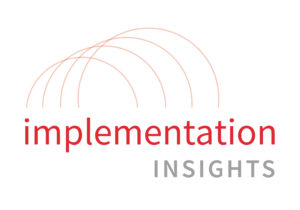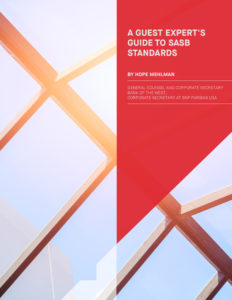Schnitzer Steel Industries, Inc. (NASDAQ: SCHN) is one of the largest manufacturers and exporters of recycled metal products in North America. The company, founded in 1906, recently joined the SASB Alliance and celebrated its seventh straight year as one of the World’s Most Ethical Companies according to The Ethisphere® Institute. We connected with Robert Ellsworth, Director of Sustainability, to discuss a unique approach to managing ESG risks and opportunities on the heels of Schnitzer’s 2021 sustainability report.
Why did you decide to use SASB Standards to communicate with investors?
Sustainability is a core value for Schnitzer – key to our long-term business planning and critical in assessing ESG risks and opportunities. Voluntary reporting using SASB Standards to communicate relevant sustainability and ESG issues is part of Schnitzer’s commitment to transparency.
Our decision in 2019 to follow the SASB Standard for Iron & Steel Producers, and publish a SASB table in our sustainability report, was part of an expansion of our overall sustainability performance measurement process. Prior to SASB, we reported using the GRI Standards within our annual corporate sustainability report, submitted responses to the CDP’s climate and water security questionnaires and completed the S&P Global Corporate Sustainability Assessment (CSA).
We discovered the SASB Standards while investigating ESG reporting options that provided a more specific scope, seeking a customizable reporting option without sacrificing industry-peer comparability. We found the SASB Standards and quickly realised that the framework would complement our existing disclosures while providing industry-specific, decision-useful information to investors and motivating greater disclosure by our industry peers.
Many small-cap companies perceive sustainability disclosure as costly, time-consuming or resource-intensive. How did Schnitzer justify implementing SASB Standards and what has the “return on effort” looked like?
For small-cap companies, internal resources with expertise and dedicated responsibility for ESG reporting are often limited, and the proverbial hill-to-climb can seem insurmountable. My advice is to not attempt to reinvent the wheel. Start slowly by reviewing disclosure activities of industry peers and work to determine where your company fits into the conversation.
Schnitzer is considered a small-cap company with a powerful sustainability story and valuable ESG profile. Our process for implementing SASB Standards in our reporting was less of a conversation about how to start, and more of a reframing of how to leverage our existing work in this area.
We assessed the SASB Standard for our industry as well as the overall SASB Materiality Map , and justified disclosure after determining that additional cost, time, and resource commitments beyond the company’s existing reporting requirements would be minimal.
The return on effort increased as we recognised the SASB Standards as a mechanism for refining Schnitzer’s sustainability story – the net-positive impact of our operations, the deep-rooted benefits of our products and services, and ultimately the company’s overall ESG value.
How do SASB Standards complement the disclosures you make that are guided by other frameworks or standards, such as GRI, CDP, and TCFD?
Viewed alongside GRI, CDP and TCFD disclosures, the SASB Standards give a high-level overview of top material ESG issues for our industry. Many, if not all, the same issues are covered in GRI, CDP and TCFD, in more granular detail and using a wider scope. For many companies, especially small caps, this additional detail and scope is not necessary to effectively articulate ESG strategy. SASB Standards offer specific, high-quality, and easily accessible information of the reporting organisation for meaningful review by investors and shareholders, and other ESG-minded stakeholders.
Does Schnitzer management use the information from your SASB-aligned disclosures to guide its own internal decision making? If so, how?
SASB-aligned disclosures provide a platform for internal discussions around the direct impact of ESG issues to the business. Specifically, the disclosures promote creative conversations and offer strategic direction around how to operationalize ESG and sustainability issues to improve performance – ie. reduce emissions, mitigate risks, realise opportunity, build a more resilient supply chain, or improve safety culture.
From disclosing additional metrics to making reconciliations to engaging an independent third-party assurance provider, Schnitzer has made extra efforts to ensure investors have access to reliable, decision-useful information. Why is that important?
First and foremost, our sustainability disclosure strategy is aligned with the company’s longstanding core values of safety, sustainability and integrity. The extra effort we make to provide this information provides an opportunity to showcase the company’s value beyond strictly financial performance. Through our sustainability reporting, we foster greater dialogue with investors that strengthens our business strategy and governance, improves our reputation, and encourages innovation.
Especially as communities, states and countries across the world commit to goals around reducing greenhouse gas emissions, promoting diversity, equity, and inclusion, and broadly improving operational performance to benefit the triple bottom line, disclosing our sustainability metrics is an essential way to differentiate Schnitzer and expand the narrative around our essential role in the economy.
What advice do you have for other companies – especially other small and medium-sized enterprises – that are beginning the process of integrating SASB Standards into their management and disclosure?
I would start by asking the question “Why is this important for our company?”. From there, the SASB Materiality Map will help identify the scope of a potential reporting and disclosure path. Cross-reference and benchmark this scope with your peers, both large and small. Discuss the proposed scope and peer research internally to allow for important dialog and engagement from relevant stakeholders. Set a realistic timeline for data gathering and determine the most efficient way to extract decision-useful information for management. Finally, build in an appropriate mechanism for feedback, keeping in mind that you will refine and improve this process each year.

